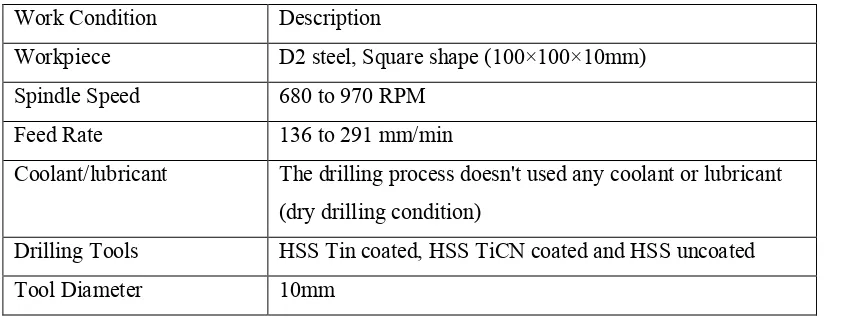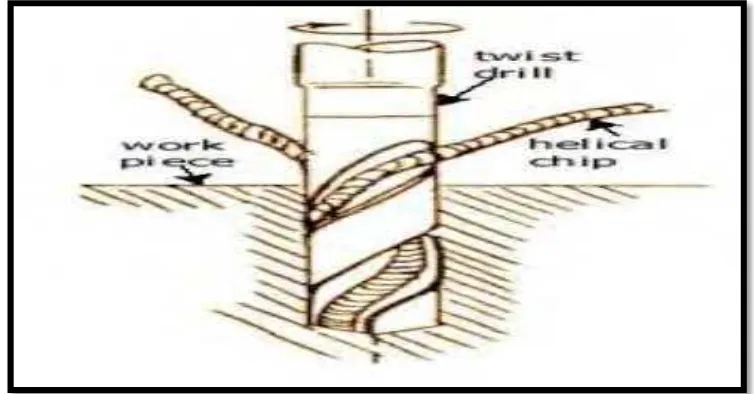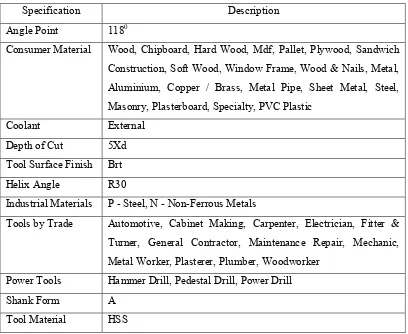UNIVERSITI TEKNIKAL MALAYSIA MELAKA
THE EFFECT OF CUTTING PARAMETER TO THE SURFACE
FINISH OF AISI D2 TOOL STEEL IN DRY DRILLING
PROCESS
This report is submitted in accordance with the requirement of Universiti Teknikal Malaysia Melaka (UTeM) for the Bachelor of Manufacturing Engineering
Technology (Process and Technology) with Honours
by
SITI HAJAR BINTI DIN B071210397
930323-01-6774
UNIVERSITI TEKNIKAL MALAYSIA MELAKA
BORANG PENGESAHAN STATUS LAPORAN PROJEK SARJANA MUDA
TAJUK: The Effect of Cutting Parameter to The Surface Finish of AISI D2 Tool Steel in Dry Drilling Process
SESI PENGAJIAN: 2015/2016 Semester 1
SayaSITI HAJAR BINTI DIN
mengakumembenarkanLaporan PSM inidisimpan di PerpustakaanUniversitiTeknikal Malaysia Melaka (UTeM) dengansyarat-syaratkegunaansepertiberikut:
1. Laporan PSM adalah hak milik Universiti Teknikal Malaysia Melaka dan penulis. 2. Perpustakaan Universiti Teknikal Malaysia Melaka dibenarkan membuat salinan
untuk tujuan pengajian sahaja dengan izin penulis.
3. Perpustakaan dibenarkan membuat salinan laporan PSM ini sebagai bahan pertukaran antara institusi pengajian tinggi.
No. 178 Blok 5 FeldaKeratong 7,
26700 MuadzamShah,
Pahang.
Disahkanoleh:
(TANDATANGAN PENYELIA)
Cop Rasmi:
iv
DECLARATION
I hereby, declared this report entitled “The effect of Cutting Parameter to The
Surface Finish of AISI D2 Tool Steel in Dry Drilling Process” is the results of my
own research except as cited in references.
Signature : ………...
Name : SITI HAJAR BINTI DIN
v
APPROVAL
This report is submitted to the Faculty of Engineering Technology of UTeM as a partial fulfillment of the requirements for the degree of Bachelor of Engineering Technology (Process and Technology) (Hons.). The member of the supervisory is as follow:
vi
ABSTRACT
In this paper the drilling of AISI D2 tool steel also called D2 steel using CNC machine of drilling operation with tool use high speed steel in different type of coating is reported. Taguchi method is used for optimizing the cutting parameter for surface finish in dry drilling operation. Dry drilling is a drilling operation where is the cutting fluid also called coolant doesn't used in this process. A number of experiments will be conducted using the L9 orthogonal array on CNC milling
vii
ABSTRAK
viii
DEDICATIONS
A special appreciation, I dedicate this thesis to my mother Habsah Binti Mohamed,
ix
ACKNOWLEDGMENTS
Alhamdulillah, I would like to thanks to Allah S.W.T, the Most Merciful, and
all praises to Allah for His blessing in completing this thesis. Special appreciation to
my supervisor, Mr. Mohd Hairizal Bin Osman for supervised and guiding me
throughout the experimental and thesis works.
I would like to express my appreciation Mr. Muhammad Syafik Bin Jumali, Mr
Syahrul Azwan Bin Sundi @ Suandi and all the technicians that help towards my
study. Sincere thanks to my beloved family and friends for their moral support and
x
LIST OF SYMBOLS AND ABBREVIATIONS xv
CHAPTER 1 INTRODUCTION 1
CHAPTER 2 LITERATURE REVIEW 5
xi
2.2.1 High Speed Steel (HSS) 9
2.2.2 PVD Coating 11
2.3 AISI D2 Tool Steel 15
2.4 Taguchi Method 16
2.5 Analysis of Variance (ANOVA) 17
CHAPTER 3 METHODOLOGY 18
3.0 Introduction 18
3.1 Flowchart of research 18
3.2 AISI D2 Tool Steel 20
3.3 Drilling Tools 21
3.4 Machining Parameter 25
3.5 Taguchi Method Design of Experiment 26
3.6 Experimental Set Up 27
3.6.1 Facing and Squaring Process 28
3.6.2 Surface Grinding Process 29
3.6.3 Drilling Process 31
3.7 Experimental Analysis 33
3.7.1 Surface Roughness Tester 33
CHAPTER 4 RESULTS & DISCUSSION 36
4.0 Introduction 36
4.1 Finding and Results 36
4.2 Surface Roughness Analysis 37
4.2.1 Signal to Noise Ratio and Mean Results of surface Roughness 37
4.2.2 Main Effects Plot for SN ratios and means 38
4.2.3 Response Table for SN ratios and Means 40
4.3 Analysis of Variance (ANOVA) 41
xii
CHAPTER 5 CONCLUSION 43
5.0 Introduction 43
5.1 Summary of Research 43
5.2 Achievement of Research Objective 44
5.3 Significance of Research 44
5.4 Problem Faced During Research 44
5.5 Suggestion for future work 45
REFERENCES 46
APPENDICES 49
APPENDIX A1 51
APPENDIX A2 52
APPENDIX A3 53
APPENDIX A4 54
APPENDIX A5 55
APPENDIX A6 56
APPENDIX A7 57
APPENDIX A8 58
APPENDIX A9 59
xiii
3.7 Flowchart of Experimental Process 27
3.8 Conventional Milling Machine (JTKP Laboratory) 28
3.9 D2 Tool Steel after Facing and Squaring Process 29
3.10 Surface Grinding Machine (JTKP Laboratory) 30
3.11 D2 Tool Steel after Surface Grinding Process 30
3.12 DMC 365 V ecoline (JTKP Laboratory) 31
3.13 The Drilling Procees Started 32
3.14 D2 Tool Steel after Dry Drilling Process 33
3.15 D2 Tool Steel on The Surface Roughness Machine 34
3.16 The Condition of Probe 34
3.17 Green Colour is at The Left of The Screen 36
3.18 The Data That Has Been Printed Out 38
4.1 Main Effects Plot for Means 39
4.2 Main Effects Plot for SN ratios 39
xiv
LIST OF TABLE
1.1 The Machining Conditioning 4
2.1 Differentiation Between The Type of Speed (Kalpakjian and Schmid, 2010)
6
2.2 The Specification of HSS Drill Bit (Sutton, 2015) 10
2.3 Wide Range of Application (TOHKEN, 2014) 12
2.4 AISI DC53 Die Steel Composition (Assabsteel, 2007) 15
3.1 The Levels of Machining Parameter 25
3.2 The Parameter at Three Level and Three Factor 26
3.3 The Experimental Design by Using L9 Orthogonal Array 26
4.1 The Experimental Result 37
4.2 Signal to Noise Ratio and Mean Result of Surface Roughness 38
4.3 The Response Table for Means 40
4.4 The Response Table for Signal to Noise Ratios (smaller is better) 40
4.5 ANOVA Results of Analysis 41
xv
LIST OF SYMBOLS AND ABBREVIATIONS
C - Carbon
CNC - Computer Numerical Control
Co - Cobalt
Cr - Chromium
Fe - Ferum
HSS - High Speed Steel
JTKP - Jabatan Teknologi Kejuruteraan Pembuatan
Ra - Mean Roughness
Ry - Maximum Peak f Roughness
Rz - Ten Point of Mean Roughness
1
CHAPTER 1
INTRODUCTION
1.0 Introduction
In the chapter one is an explanation about the introduction consists of the project background, problem statement, objectives and project scope.
1.1 Project Background
Drilling is a cutting process that uses a drill bit to cut or enlarge a hole of circular (thin slice that can be looked at) in solid materials. Holes usually are used for device that made up of smaller parts with fasteners for the design purposes such as weight reduction or access to the inside parts or for appearance. Other processes for producing holes are punching and different advanced machining processes.
During a dry drilling condition, the cutting fluid doesn’t use during the machining process. Depending on the type of machining operation, the cutting fluid needed may be a coolant, oil/grease, or both. Because the machine-tool operator is usually close together to cutting fluids, the health effects of operator contact with fluids should be the first (or most important) concern.
Usually (in the past), cutting fluids have been widely used in machining operations in efforts to increase cooling and slipperiness, and as a result improve tool life, reduce process (quality of changing over time or at a different places), etc. However, over the last ten years, it has become seen/obvious that fluid-related decisions have all too often been based upon industrial old stories rather than knowledge-based (having to do with measuring things with numbers) evidence.
2
cutting parameter for surface finish of AISI D2 tool steel. The surface roughness of the hole will be tested using surface roughness measuring tester. Minitab 17 software is used to analyze and arrange the data of experiment.
3
1.2 Problem Statement
AISI D2 is one of the most popular high-chromium and high-carbon steels of D series and it is characterized by its high compressive strength and wear resistance, good through-hardening properties, high stability in hardening and good resistance to tempering-back. Cold work tool steels of Series D, also known as die steels, are high alloy steels Fe-Cr-C-base. This alloy has the ability to preserve its desirable mechanical properties intact upon cycling over a range of temperatures, which can be an advantage for applications including, piercing and blanking dies, punches, shear blades, spinning tools, slitting cutters, as well as variety of higher-end wood working tools (V.Sistaet al. 2011, Wuu-Ling Pan et al. 1998, K.H.Prabhudev 1992) Despite good mechanical properties of D2 steel, the lifetime of pieces and accessories fabricated with this alloy is negatively affected by the increase in the severity of operating conditions due to continuing evolution of industrial processes and corrosive operation environments (Ramírez et. al, 2012). Since the properties of material D2 steel make it hard to cut or machining, the above statements provide a niche or a trend in directing this study by providing a guideline in drawing out the objectives of this research.
1.3 Objectives
This project is a study on cutting parameter in dry drilling conditions using computer numerical control (CNC) machine. Discoveries whereupon will be qualified into surface roughness estimation parameters or all the more precisely the arithmetical mean deviation (Ra). Though, there are objectives of this project:
1. To study the surface roughness of AISI D2 tool steel in dry drilling condition by using various type of cutting tools.
4
1.4 Project Scope
The effect of a surface roughness will be based on the control parameter set up.The research is conducted as shown in Table 1.1. Based on the Table 1.1, D2 steel with the dimension of 100 mm×100 mm×10 mm is used as a workpiece material. There are three type of parameter set up which is feed rate (136 mm/min, 206.25 mm/min, 291 mm/min), spindle speed (680 rpm, 825 rpm, 970 rpm) and type of drilling tools material (HSS Tin coated, HSS TiCN coated, HSS uncoated. During this experiment, the drilling process doesn’t use any coolant or lubricant. In other words, the experiment is running under dry drilling condition.
Table 1.1: The Machining Conditioning
Work Condition Description
Workpiece D2 steel, Square shape (100×100×10mm)
Spindle Speed 680 to 970 RPM
Feed Rate 136 to 291 mm/min
Coolant/lubricant The drilling process doesn't used any coolant or lubricant
(dry drilling condition)
Drilling Tools HSS Tin coated, HSS TiCN coated and HSS uncoated
5
CHAPTER 2
LITERATURE REVIEW
2.0 Introduction
In chapter two, literature review is a text of a scholarly paper, which includes the current knowledge including substantive findings, as well as theoretical contributions to a particular topic. This chapter consists of drilling process, cutting tools for drilling process, D2 tool steel, surface roughness and statistical analysis.
2.1 Drilling Process
The manufacturing process used in this project is high speed machining in dry drilling condition where lubricant and coolant doesn’t used in the drilling process.
2.1.1 High Speed Drilling
6
Table 2.1: Differentiation Between The Type of Speed (Kalpakjian and Schmid, 2010)
Type of Speed Speed (m/min)
High speed 600-1,800
Very high speed 1,800-18,000
Ultra high speed 18,000
2.1.2 Drilling
Drilling is a cylindrical hole opening process on a workpiece with cutting tools. Drilling can be applied to various workpieces and materials. A higher degree of tolerance accuracy may not be necessary at the hole for the bolt, screw and other components. However, at the critical holes such as wedge hole or mould pins tolerance accuracy becomes important (Krar et. al, 1998).
7
Figure 2.1 : Process of Gray Scale Transformation
Although long spiral chips usually result from drilling, adjustment of the feed rate can result in chips with a range of many different shapes and sizes. Material of work piece can also change the range of different chip shapes and sizes generally, the hole diameters produced by drilling are slightly larger than the drill diameter (oversize). The amount of oversize depends on the quality of the drill and also the equipment that used as well as the machinist skill. (Sretenović et. al, 2014)
2.1.3 Dry Drilling
8
In 2002, over two billion gallons of cutting fluids were used by North American manufacturers. Traditionally, cutting fluids have been widely used in machining operations in efforts to increase cooling and lubricity, and as a result enhance tool life, reduce process variability, etc. However, over the last decade, it has become apparent that fluid-related decisions have all too frequently been based upon industrial folklore rather than knowledge-based quantitative evidence. Recently there has been a change in this situation, in part driven by the fact that costs associated with fluid use often constitute between 7% and 17% of total production costs, as compared to 4% for tooling costs (King et al., 2001).
Cutting fluids have seen extensive use and have commonly been viewed as a required addition to high productivity and high quality machining operations. Cutting fluid related costs and health concerns associated with exposure to cutting fluid mist and a growing desire to achieve environmental sustainability in manufacturing have caused industry and academia to re-examine the role of these fluids and quantify their benefits.
9
2.2 Cutting Tools for Dry Drilling
This project used high speed steel (HSS) as a cutting tools. There are three type of HSS used:
a) HSS Uncoated b) HSS TiN Coated c) HSS TiCN Coated
2.2.1 High Speed Steel (HSS)
10
Table 2.2: The Specification of HSS Drill Bit (Sutton, 2015)
Specification Description
Angle Point 1180
Consumer Material Wood, Chipboard, Hard Wood, Mdf, Pallet, Plywood, Sandwich Construction, Soft Wood, Window Frame, Wood & Nails, Metal, Aluminium, Copper / Brass, Metal Pipe, Sheet Metal, Steel, Masonry, Plasterboard, Specialty, PVC Plastic
Coolant External
Depth of Cut 5Xd
Tool Surface Finish Brt
Helix Angle R30
Industrial Materials P - Steel, N - Non-Ferrous Metals
Tools by Trade Automotive, Cabinet Making, Carpenter, Electrician, Fitter &
Turner, General Contractor, Maintenance Repair, Mechanic, Metal Worker, Plasterer, Plumber, Woodworker
Power Tools Hammer Drill, Pedestal Drill, Power Drill
Shank Form A



